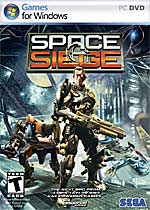Crab Season is Over
Developers appear to have their eyes on the science-fiction crowd, and Space Siege is another fantasy-turned-science video game that backs that up. The spiritual successor to Dungeon Siege II, a popular and moderately acclaimed RPG, Space Siege attempts to harness what made its predecessors popular, while still attracting newer audiences. Unfortunately for Gas Powered Games, they seemed to pay more attention to the setting than they did to the game mechanics.

The player fills the role of Seth Walker, a solider aboard one of the massive colony ships fleeing Earth. As with most science-fiction games, there are the hostile aliens known as the Kerak, bearing down, ready to exterminate humanity in an instant. The opening cutscene shows Walker’s ship escaping the assault on Earth, but not before a smaller Kerak ship attaches itself to his hull and lays siege.
Visually, Space Siege does a great job with the direction taken. As a third-person RPG with a top-down perspective, the game has difficulty showing off some of its more impressive visuals, since the player is usually staring at the top of Walker’s head and examining the bolts in the flooring. Nevertheless, there are moments, particularly when crossing catwalks and large bridges, when the player is treated to something more than sterile interiors.
The design direction isn’t necessarily dull, but it doesn’t make much of an effort to create an immersive experience. The lack of blood is strange in contrast to the savage massacre of mankind. Hallways lined with dead bodies feel empty and barren without gory detail. Similarly, because the entire game’s plot unfolds on a single ship, much of the interior environment will start to look oddly familiar after about thirty minutes. There are a few out-of-ship environments, but they are limited and too few. However, this isn’t to say that any of these things equate to a poor visual presentation, it just wasn’t expected.
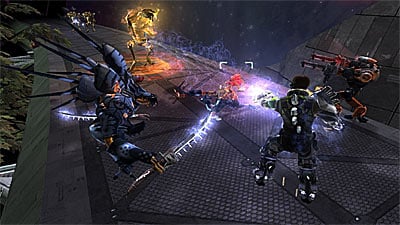
The cinematic cutscenes, which are few in number, are actually done rather well but are completely limited to scenes involving spaceships and space combat, so the depth of the cutscenes is severely limited. The in-game cutscenes, on the other hand, seem almost pointless, since most of them do little more than take control away from the player and switch between two different camera angles for a few seconds. And, since most of the dialog and story unfolds via some unseen communication device that allows the characters’ faces to appear as they talk, which happens even during the cutscenes, it makes the player wonder why Gas Powered Games bothered creating them at all.
Character animations, especially during melee combat moves, are fluid and top-notch. However, outside of combat, animations seem stiff or are just not there. For example, there are only a handful of moments when NPC allies will actually be animated when talking, preferring to remain in the standing position or hunched over a computer console instead. In fact, it would be difficult to even tell they were alive if they weren’t talking.
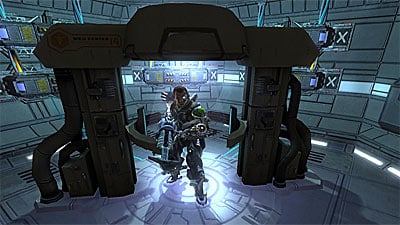
Despite the many things that were changed since Dungeon Siege 2, Gas Powered Games’ decision to keep point-and-click character movement may have been the wrong one. Since left-clicking moves the character and right-clicking is to attack, doing both at the same time is impossible. Sure, one could argue that this makes the game more difficult or painfully annoying, but most gamers, even FPS-oriented ones, shouldn’t find it too difficult to master.
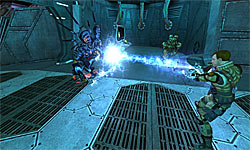
While point-and-click character movement and combat isn’t exactly ideal, the controls also suffer from a lack of customization. While most games make up for faulty controls by allowing the player to customize them, Space Siege has no such feature, forcing the player to play the game with default controls. Even though the ability to remap specific controls to different keys isn’t available, if the game had utilized a more console-style configuration, which allows players to switch between different preset control schemes, it would have been better than nothing. Unfortunately, Space Siege offers neither and leaves the player at a loss in this regard.
The voice acting isn’t exactly the greatest, but it isn’t terrible overall. Nevertheless, some voices can be difficult to take and others don’t really breathe much life into the characters. In fact, the voice acting lacks any real emotion, similar to that in GPG’s Supreme Commander. While good voice acting for an RTS game that’s focused on large-scale combat isn’t such an issue, good voice acting for an Action/RPG is essential.
Despite the distanced, third-person perspective, Space Siege manages to provide quality sound effects. Unfortunately, there isn’t much in the way of variety, so no matter how immersive the effects are, they become repetitive. All the weapons have a unique sound, but that probably wasn’t difficult considering there are a total of eight.

The music isn’t going to drive gamers to purchase the soundtrack, if there was one, but it isn’t going to make them hurl their speakers or headphones off a bridge either. In fact, the music, when compared to the sound effects and voice acting, is the best at creating any real tension or atmosphere. Unfortunately, that very same tense atmosphere is almost instantly driven off by the sounds of a voice actor overdoing some lines on a piece of paper.
Space Siege hails itself as an Action/RPG, but it seems to lack almost all the characteristics of an RPG. The player does have two different skill trees on which to place skill points: Combat and Engineering. The Combat tree has a number of different skills involving damage percentages and armor buffs, while the Engineering tree involves skills that improve the player’s ability to craft helpful gun sentries, combat robots, and buff the main robot companion known as HR-V (Har-vee).
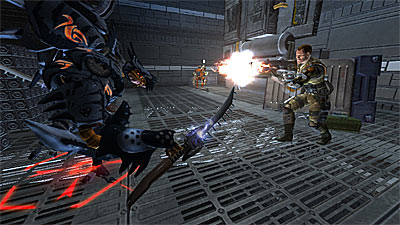
However, the skill trees are limited by one major factor: Installing cybernetic implants. While the player is involved in removing the alien presence aboard the colony ship, a small side-story unfolds involving the ethical problems associated with cybernetic implants. Are they good, are they bad, when is it too much, how much of one’s humanity should be sacrificed to save humanity… all the philosophical questions gamers could ask for. The problem is that more than half of the skills on both trees require the installation of a specific cybernetic part. So, if you want that increased damage skill, the player may have to remove their eye and replace it with a cybernetic one, making them more robot than man.

In an attempt to offset the imbalance between the limited number of skills for human players and the more numerous amount for cybernetic players, GPG gives each tree one skill that provides large bonuses, as long as the player remains 90% human. To make the situation worse, those two skills are the only perks for deciding to stay mostly human, unless the player counts feelings of self-satisfaction, but that certainly isn’t a gameplay element GPG coded.
Space Siege deviates from classic and fun RPG mechanics by eliminating experience points and character levels. Sure, this takes the pain away from grinding for levels or experience, but it also reduces the possibility of non-linear gameplay to zero. Players earn two skills points at scripted stages of the game, making it the exact same character progression experience every time it’s played, which completely undermines the very notion of replay value.
And, while RPGs are known for being nothing short of “treasure hunts” where players will search long and hard for the best weapons, armors, and upgrades, Space Siege removes all of that by telling the player exactly what weapons are usable and when they can be picked up. This same idea also applies to the cybernetic implants that are found. So, even though weapons can be upgraded, the player can’t find a better version of a rifle or even craft one. Instead, the player accumulates machine parts throughout the game which can be traded for upgrades, grenades, health packs, and other various items. In this sense, Space Siege is more like a standard side-scrolling adventure game, but instead of hunting for shiny rings or gold coins, the player is hunting for spare parts.
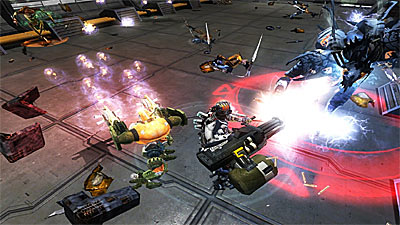
The single-player campaign provides a rigid and linear gameplay experience, but GPG designed the multiplayer component almost exactly the same way. Up to four players can connect together using GPG’s service, GPGNet. And, instead of the players completing the same story and objectives they did in the single-player campaign, the multiplayer takes place on an entirely different colony ship, with an entirely different set of objectives. Unfortunately, there is only one multiplayer scenario, meaning that once completed, the only option is to keep playing it over and over. Add to this the lack of a map or level designer, and the multiplayer experience ends up equaling the single-player experience in replay value.
Overall, Space Siege is mildly entertaining, but many of its features will leave the player feeling unsatisfied. Conversely, Space Siege does manage to do some things right, such as making combat fun, which is practically a given considering how much time is spent cutting through enemies. The lack of atmosphere, tension, and urgency doesn’t help either, especially since the player is supposed to feel like humanity is on its last leg. The characters fit into the common stereotypes, making them far too shallow to be interesting. In the end, Space Siege attempts to blend the Action and RPG genres, but all it manages to do is strip the best parts of both and throw what’s left into a heap of cybernetic rubble, making fans of both genres equally disappointed.
RATING OUT OF 5 RATING DESCRIPTION 3.5 Graphics
A visually stimulating game hindered mostly by the top-down, third-person perspective. 3.0 Control
Nonexistent customization and poor handling of default controls makes combat not as interesting as it could be. 3.5 Music / Sound FX / Voice Acting
Decent musical scores and sufficient sound effects are scarred by poor voice acting. 2.5 Play Value
Completely linear gameplay reduces the replay value to zilch, while the multiplayer experience is almost just as linear. The RPG elements feel tacked on and underdeveloped. 3.0 Overall Rating – Fair
Not an average. See Rating legend above for a final score breakdown.
Game Features:
